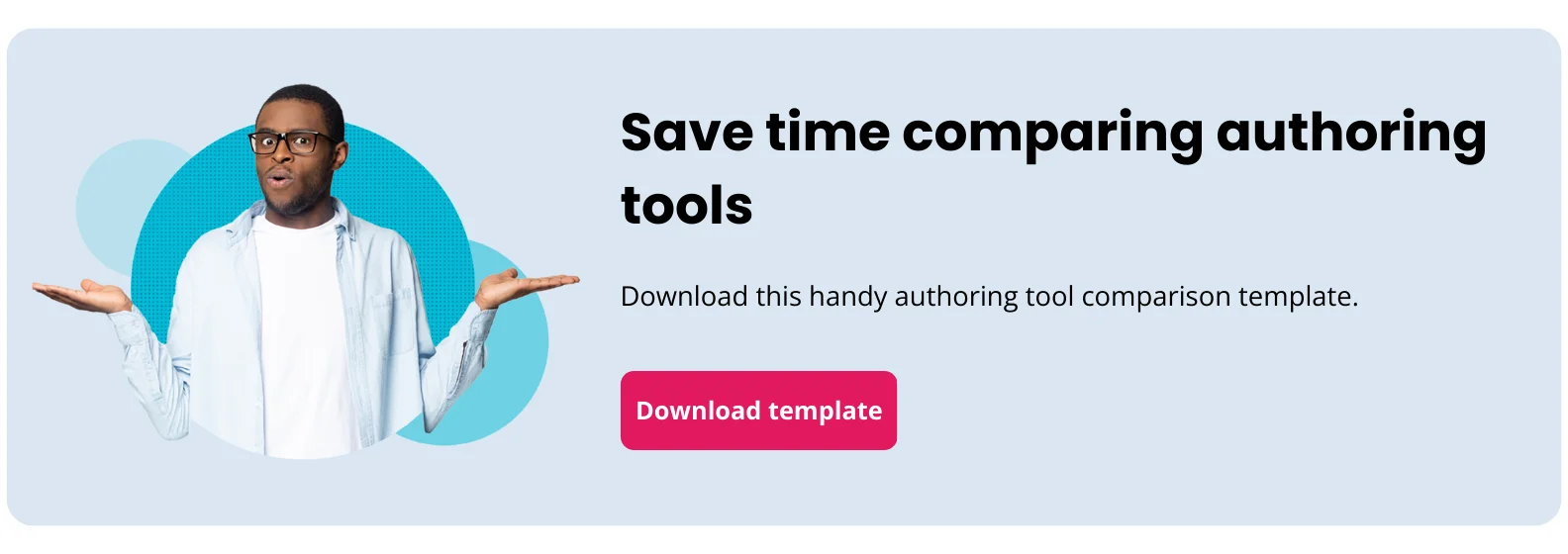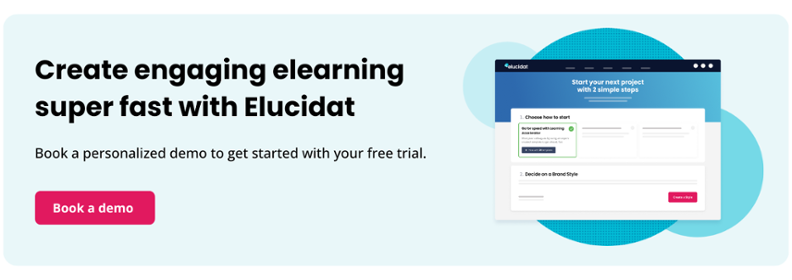The 13 best SCORM authoring tools to watch
10 minute read
If your plan for this year is to create awesome SCORM-compliant elearning, you might be wondering what are the best SCORM authoring tools available right now. Whether you’re starting out in course creation or looking for an upgrade, our guide gives you an overview of some of the top SCORM authoring softwares. There are many platforms out there for creating SCORM content, so make sure you choose a SCORM course builder that’s right for you and your team!

What are SCORM authoring tools?
An authoring tool can be used to create and maintain web-based content. It’s created in a standardized course structure that can be exported in several different formats. SCORM stands for Shareable Content Object Reference Model. It means your content can run from any LMS that’s compatible with SCORM. Simply upload your zip package and you’re ready to go.
Want to find out more about SCORM? Check out our blog post: What is SCORM?
Types of SCORM authoring tools
SCORM authoring tools come in all shapes and sizes. There are two key types:
- Cloud-based authoring tools exist entirely online. They’re hosted on an external server. No download and install are needed.
- Desktop authoring tools are installed on your desktop. They may or may not require the Internet to work.
There are pros and cons to both types of SCORM-compliant authoring tools. Here are the things you should keep in mind when choosing the type of SCORM creation tools.
Need a hand with comparing tools? Check out our handy scorm authoring tool comparison template.

Internet access
Cloud-based SCORM content authoring tools can be accessed anytime, anywhere – as long as you have access to the Internet. From building to publishing, user management to storage – it all happens online. Everything is saved to the cloud. You don’t have to constantly back up your work, and there’s no chance of losing it. Software updates are automatic, so you’ll always work with the latest features and bug fixes.
If you have limited access to the Internet, a desktop SCORM authoring tool might be best for you. As the tool is installed on your device, you can access it wherever you’re working – even without an Internet connection. Everything is stored on your hard-drive. There’s only one copy, so remember to back up your work. You’ll also need to manually check for software updates when you go online.
Ease of use
Cloud-based SCORM authoring tools are generally less complicated than desktop software. Complex layouts and advanced features mean desktop tools can have a steep learning curve.
If you need customized interactions or complicated branding, you may need intensive SCORM training or to hire an expert. Publishing content is time-consuming. Once published, it can also be hard to update.
Cloud-based authoring tools are more user-friendly. An intuitive interface means you can start building content straight away. Sharing, duplicating and updating content is easy with these flexible tools.
Collaboration
If you’re working alone, a desktop SCORM authoring tool might be for you. But even for the smallest project, collaboration is key. It’s likely you’ll need to involve subject matter experts and stakeholders to input on your online training. With a desktop tool, content needs to be created, converted, and published before it can be shared. This can make your feedback process longer and more laborious.
In contrast, collaboration between multiple people is easy with a cloud-based tool. Authors and reviewers can work on the same content at the same time. Effective collaboration speeds up content creation and produces better learning courses.
How to use a SCORM authoring tool
SCORM authoring tools are essential for creating elearning content that can be used in most LMSs. Here are some simple steps to help you get started with using a SCORM authoring tool:
- Choose a tool that fits your needs and budget – Research SCORM authoring tools that meet your needs and budget, and choose the best option for you.
- Activate your account – If you’re using a cloud-based tool, set up your account and get your users added in so they can start creating content. If you’re using a desktop tool, download and install the software, then open it to begin creating your elearning course.
- Create a new project, and choose a template or start from scratch – It’s time to start creating content! To create a new project in your authoring tool, either choose a pre-designed template or start from scratch. Be sure to set up any brand styles early on to maintain consistency.
- Add your content –Now for the important part – your content. Be sure to keep your content short and sweet so it is digestible for your learners. Don’t forget to include engaging interactions to ensure your learners stay focused.
- Invite your team to review – Once you are happy with your content, it’s time for your team to review. Share your course content via file share, online link, or just invite them straight into the platform.
- Test your course – Check that your elearning course is SCORM compliant and ensure that it runs smoothly before publishing. Be sure to test this mobile and tablets to ensure your course scales and looks great on all screen sizes.
- Publish your elearning course – Finally, it’s time to share your content. Release your elearning course into a SCORM package and upload it to your LMS for learners to access. You can then track their progress and make updates from your authoring tool to improve and refine.
By following the seven simple steps outlined above, you’ll be able to get started with creating your own SCORM-compliant elearning courses that deliver impactful learning experiences.
Top 13 SCORM elearning authoring tools
Ultimately what LMS authoring tools you choose depends on you and your team’s needs. Are you:
- Building alone or collaborating?
- Keeping it simple or highly customized?
- Using open source SCORM authoring tool community support or intensive training?
- Using a free SCORM authoring tool or bigger budget software?
There’s clearly plenty to consider and lots of SCORM-compliant online learning software that will meet your needs. Here’s our guide to the top thirteen SCORM authoring tools.
1. Elucidat
- Type: Cloud-based
- SCORM support: 1.2 / 2004
- Platform: Windows / Mac
With Elucidat, you can crowdsource your corporate elearning from hundreds of colleagues. Whatever your level of expertise, creating interactive, mobile-friendly courses is easy. Packed with features and ready-made learning blueprints, you can get up and running fast.
Elucidat is cloud-based. People can work on the same project at the same time, while you stay in control. You’re able to clone your course, so reuse, rebranding and translation are simple. And all without version control, thanks to your master course.
If you’re transitioning from PowerPoint-based training, Elucidat also enables you to quickly convert PowerPoint to SCORM-compliant content. This can save you time and effort while allowing you to reuse existing content in a new, interactive format that’s fully compatible with your LMS.
Want to learn more about how Elucidat can help you create SCORM compliant content? Book a demo!

2. Articulate Storyline 360
- Type: Desktop
- SCORM support: 1.2 / 2004
- Platform: Windows
Articulate Storyline 360 combines a series of interactive slides to create online learning content. If you know your way around PowerPoint, you have a good base knowledge to build on. If you’re experienced, you can use the tool to create customized interactions and bespoke branding options.
It’s a desktop tool, so you’ll find it easier to build content alone. An export feature speeds up localization and translation. But remember to adjust text to fit when you import your new languages.
3. Articulate Rise 360
- Type: Cloud-based
- SCORM support: 1.2 / 2004
- Platform: Windows
If you’re new to content creation, Articulate Rise 360 is a good place to start. An intuitive interface with ready-to-use templates means you can create basic mobile-friendly online training easily.
It’s cloud-based, so collaboration and review happen in one place. The ability to clone courses means you can speed up the localization and translation process.
Explore how Articulate Storyline, Rise and Elucidat shape up in this comparison and review – and decide which tool is best for you!
4. Adobe Captivate
- Type: Desktop
- SCORM support: 1.2 / 2004
- Platform: Windows / Mac
Working like PowerPoint presentations, Captivate enables you to produce basic learning content. If you’re more experienced or ready for a bit of a learning curve, you can explore the advanced features. Its screen recorder can be used for systems demos and sandpits. Mobile gestures and geo-location can produce more innovative learning.
Captivate is a desktop app, so collaboration isn’t straightforward. Publishing, sharing, reviewing, updating is time-consuming. Translation can also be laborious.
5. iSpring Suite
- Type: Desktop
- SCORM support: 1.2 / 2004
- Platform: Windows
The iSpring suite is based on PowerPoint. From simple text and graphics to more complex drag and drop questions, choose from a range of interactions to create responsive elearning courses. With a library of assets available, you have everything you need to produce content quickly.
The iSpring toolkit is desktop-based, so teamworking is inefficient. Reusing learning paths and courses can speed up your process. But if you need to update at scale, having no direct links to courses can cause issues.
See which tool best suits your needs in this full Elucidat vs iSpring Suite comparison and review.
6. Camtasia
- Type: Desktop
- SCORM support: 1.2 / 2004
- Platform: Windows / Mac
Specializing in screen recordings and video editing, Camtasia can export learning content as a SCORM package. It may not be as powerful as the other tools, but this SCORM content creator is easy to use. Demo a system, record a narration, add in some interactivity – there are lots of excellent options with this tool.
As with other desktop tools, Camtasia is best if you’re working alone.
7. Gomo
- Type: Cloud-based
- SCORM support: 1.2 / 2004
- Platform: Windows / Mac
Gomo is an authoring tool for mobile-first learning content. Ready-made templates and a quick-start wizard can help you get up to speed. Designed for content developers rather than novices, you may need to hire a specialist if you have grand plans.
It’s a cloud-based app, so collaboration happens in one place. With the option to deliver one course where people select their language, Gomo is worth considering if your organization is international.
Get the full spec on this tool in this Elucidat vs Gomo Learning comparison and review article.
8. Knowbly
- Type: Cloud-based
- SCORM support: 1.2 / 2004
- Platform: Windows / Mac
Knowbly is a simple but powerful tool for creating mobile-friendly learning content. A standard set of tools helps you build learning packed with interaction.
Knowbly is a cloud-based tool, so has a built-in review and real-time collaboration tool. A centralized source makes localization, translations and updates easier.
9. Adapt
- Type: Desktop
- SCORM support: 1.2 / 2004
- Platform: Windows, Mac OS
Adapt is a complex online authoring tool that, while relatively easy to use, does require a certain level of technical development expertise in order to create SCORM-compliant online elearning content.
It has an easy-to- manage asset library, a decent range of interactions and assessment features and a good selection of modern, professional content themes to choose from. Publishing SCORM releases is a quick and straightforward download.
10. Lectora Online
- Type: Cloud-based
- SCORM support: 1.2 / 2004
- Platform: Windows, Mac OS
Lectora is one of the most mature authoring tools on the market. Its younger sibling Lectora Online is a powerful HTML5 cloud-based version of the original tool.
Unlike some of the other tools in the review, it can be more difficult to get to grips with as it is designed with experienced authors in mind. However, once you have mastered it, Lectora Online allows you to build highly-customizable and attractive corporate learning projects. Some of the best features include free access to Elearning Brothers graphics libraries and the online reviewer collaboration tool, which enables multiple stakeholders to edit content and add comments in one place.
11. Easygenerator
- Type: Cloud-based
- SCORM support: 1.2 / 2004
- Platform: Windows, Mac OS
As the name suggests, Easygenerator is one of the most simple-to-use SCORM authoring tools in this review. It offers reasonable design functionality and interactions but may not be suitable for authors looking to create sophisticated, highly bespoke interactive digital learning.
Easygenerator’s “co-authoring” feature is useful for collaboration between multiple stakeholders, and it has a range of great mobile-friendly responsive design features, making it easy to create multi-device compatible content.
12. DominKnow ONE
- Type: Cloud-based
- SCORM support: 1.2 / 2004
- Platform: Windows, Mac OS
DominKnow has strong responsive design capabilities and a wide range of themes and templates for you to choose from and make your own.
Despite having a slightly complex interface, it’s generally easy to use and there are lots of useful time-saving features such as the ability to copy courses and have multiple authors collaborate on content in real-time. There is an informative product tour within the tool that provides guidance and tips on how to navigate the tool to help you get up to speed.
13. Evolve
- Type: Desktop
- SCORM support: 1.2 / 2004
- Platform: Windows
One of the best SCORM authoring tools designed for novice authors is Evolve. It allows users to build simple content quickly with a range of intuitive components and pre-built templates.
With Evolve, authors can make changes at scale with just a few clicks and have the option whether to release the courses via web or offline. One of the biggest benefits of creating corporate elearning content in Evolve is that it’s compatible with any platform, device or operating system.
In summary
Whether you’re new to SCORM-compliant authoring software or looking to upgrade your SCORM creator, there’s plenty of software to choose from. You’ve seen our summary of the best SCORM software out there; now, take a look for yourself.
Start creating compliant courses today with the help of SCORM-compliant blueprints. Book a demo of Elucidat and we’ll get your free trial off to a flying start!




